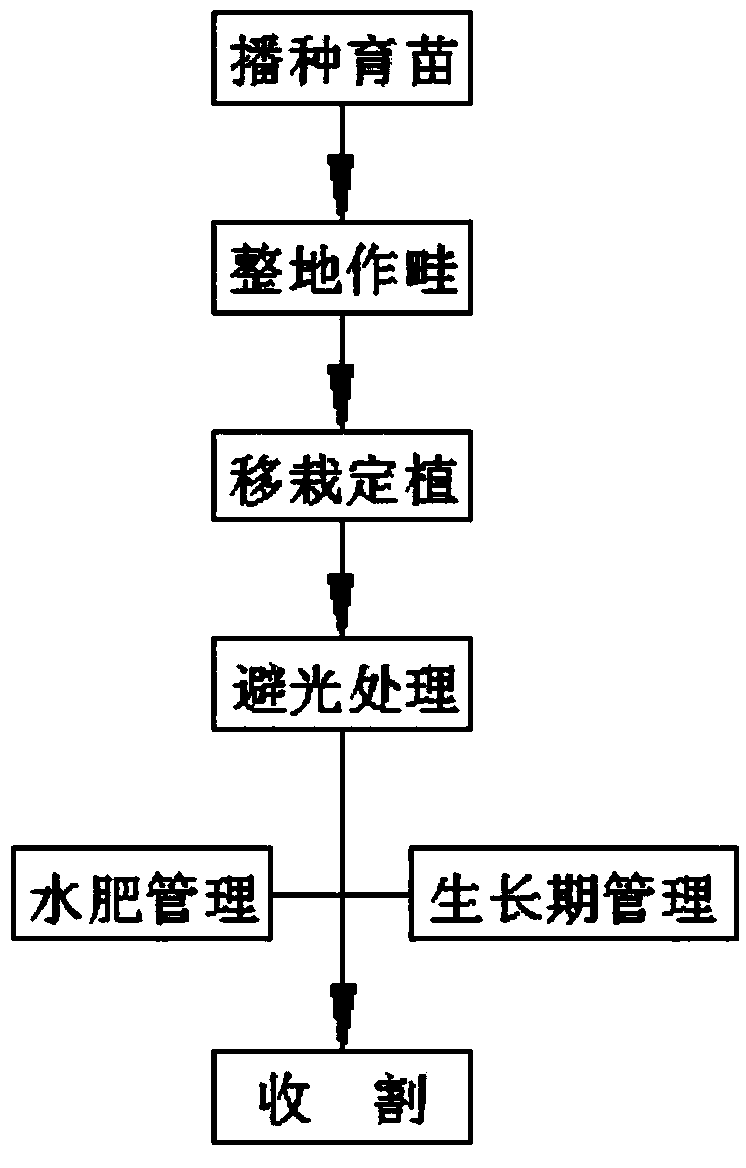Cultivation method of chives
A cultivation method and technology of chives, applied in fertilization methods, botanical equipment and methods, horticulture and other directions, can solve the problems of low yield per unit area, high labor intensity, and a large number of manpower, etc., to reduce labor intensity, shorten growth cycle, The effect of reducing usage
- Summary
- Abstract
- Description
- Claims
- Application Information
AI Technical Summary
Problems solved by technology
Method used
Image
Examples
Embodiment 1
[0024] A method for cultivating chives, comprising the steps of:
[0025] (1) Sowing seedlings: select leek varieties that are resistant to diseases and insect pests, cold resistance, heat resistance, strong branching power, good appearance and internal quality, cultivate them in greenhouses, sow seeds in mid-to-late April, and use an average of 4 kg per mu of land, Cultivate for 6 to 7 months to grow the roots with strong seedlings. During this period, leeks are harvested 3 times. When the leeks are harvested for the third time, 2 to 3 cm leek stems are reserved;
[0026] (2) Soil preparation and furrowing: choose dry land that can be irrigated in drought and can be drained in waterlogging. It is advisable to choose sandy soil with a pH below 7.5. Deeply turn the land once or twice to a depth of at least 30cm. Remove weeds in the middle, apply basal fertilizer, deep plow into the soil, and level the furrow. The base fertilizer is compound fertilizer or decomposed ring fertil...
Embodiment 2
[0035] A method for cultivating chives, comprising the steps of:
[0036] (1) Sowing seedlings: select leek varieties that are resistant to diseases and insect pests, cold resistance, heat resistance, strong branching ability, good appearance and internal quality, cultivated in greenhouses, sow in mid-to-late April, and use an average of 6 kg of seeds per mu of land, Cultivate for 6 to 7 months to grow the roots with strong seedlings. During this period, leeks are harvested 3 times. When the leeks are harvested for the third time, 2 to 3 cm leek stems are reserved;
[0037] (2) Soil preparation and furrowing: choose dry land that can be irrigated in drought and can be drained in waterlogging. It is advisable to choose sandy soil with a pH below 7.5. Deeply turn the land once or twice to a depth of at least 30cm. Remove weeds in the middle, apply basal fertilizer, deep plow into the soil, and level the furrow. The base fertilizer is compound fertilizer or decomposed ring ferti...
Embodiment 3
[0046] A method for cultivating chives, comprising the steps of:
[0047] (1) Sowing seedlings: select leek varieties that are resistant to diseases and insect pests, cold resistance, heat resistance, strong branching force, good appearance and internal quality, cultivate them in greenhouses, sow seeds in the middle and late April, and use 5 kg of seeds per mu on average. Cultivate for 6 to 7 months to grow the roots with strong seedlings. During this period, leeks are harvested 3 times. When the leeks are harvested for the third time, 2 to 3 cm leek stems are reserved;
[0048] (2) Soil preparation and furrowing: choose dry land that can be irrigated in drought and can be drained in waterlogging. It is advisable to choose sandy soil with a pH below 7.5. Deeply turn the land once or twice to a depth of at least 30cm. Remove weeds in the middle, apply basal fertilizer, deep plow into the soil, and level the furrow. The base fertilizer is compound fertilizer or decomposed ring ...
PUM
 Login to View More
Login to View More Abstract
Description
Claims
Application Information
 Login to View More
Login to View More - R&D
- Intellectual Property
- Life Sciences
- Materials
- Tech Scout
- Unparalleled Data Quality
- Higher Quality Content
- 60% Fewer Hallucinations
Browse by: Latest US Patents, China's latest patents, Technical Efficacy Thesaurus, Application Domain, Technology Topic, Popular Technical Reports.
© 2025 PatSnap. All rights reserved.Legal|Privacy policy|Modern Slavery Act Transparency Statement|Sitemap|About US| Contact US: help@patsnap.com

